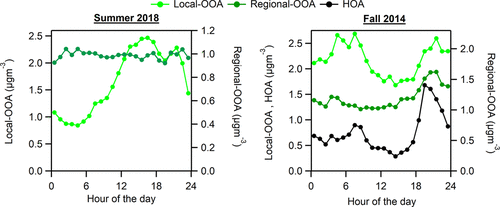当前位置:
X-MOL 学术
›
ACS Earth Space Chem.
›
论文详情
Our official English website, www.x-mol.net, welcomes your feedback! (Note: you will need to create a separate account there.)
Effects of Sources and Meteorology on Ambient Particulate Matter in Austin, Texas
ACS Earth and Space Chemistry ( IF 3.4 ) Pub Date : 2020-03-16 , DOI: 10.1021/acsearthspacechem.0c00016 Kanan Patel 1 , Dongyu Wang 1 , Puneet Chhabra 1 , Jeffrey Bean 1 , Surya Venkatesh Dhulipala 1 , Lea Hildebrandt Ruiz 1
ACS Earth and Space Chemistry ( IF 3.4 ) Pub Date : 2020-03-16 , DOI: 10.1021/acsearthspacechem.0c00016 Kanan Patel 1 , Dongyu Wang 1 , Puneet Chhabra 1 , Jeffrey Bean 1 , Surya Venkatesh Dhulipala 1 , Lea Hildebrandt Ruiz 1
Affiliation

|
We measured ambient submicron aerosol at an urban background site in Austin, Texas in June 2018 (summer) and October–November 2014 (fall). We report the NR-PM1 (non-refractory particulate matter with aerodynamic diameter under 1 μm) concentration, size distribution, and bulk composition measured with a quadrupole-aerosol chemical speciation monitor and a scanning electrical mobility spectrometer. Source apportionment of organic aerosol (OA) using positive matrix factorization (PMF) resolved two oxidized factors, local and regional-OOA, for the summer period and an additional factor, hydrocarbon-like OA (HOA), for the fall period. Differences in the diurnal variation of the local-OOA factor during the two periods and the absence of an HOA factor in the summer indicate that photochemical processing played an important role in governing summer OA composition and diurnal variation. Concentrations of particulate sulfate (SO42–) were higher in summer than fall, which may be due to emissions from cement kilns located upwind of the measurement location under the summer wind conditions. Size distribution data suggest frequent nucleation events in summer afternoons, possibly initiated by SO2 and high photochemical activity, and supported by low particle loading and, therefore, a low condensational sink. Overall, we demonstrate the importance of sources, meteorological conditions, and photochemistry in governing the composition and concentration of PM1 at this urban background site.
中文翻译:

得克萨斯州奥斯汀市的气象资源对环境颗粒物的影响
我们于2018年6月(夏季)和2014年10月至2014年11月(秋季)在得克萨斯州奥斯丁的城市背景站点测量了环境亚微米气溶胶。我们报告NR-PM 1(空气动力学直径在1μm以下的非难熔颗粒物质)的浓度,尺寸分布和整体组成,使用四极气溶胶化学形态监测器和扫描电迁移率仪进行测量。使用正矩阵分解(PMF)进行有机气溶胶(OA)的源分配可解决两个氧化因子,即夏季的局部和区域OOA氧化,以及秋季的烃类OA(HOA)等其他氧化因子。这两个时期局部OOA因子日变化的差异以及夏季没有HOA因子的变化表明,光化学处理在控制夏季OA组成和日变化方面起着重要作用。硫酸盐(SO 4 2–)夏季高于秋季,这可能是由于夏季风条件下位于测量位置上风的水泥窑的排放所致。粒度分布数据表明,夏季午后频繁发生成核事件,这可能是由SO 2和高光化学活性引起的,并受到低颗粒负载和低凝结沉降的支持。总体而言,我们证明了在这个城市背景站点上,控制源PM 1的组成和浓度时,来源,气象条件和光化学的重要性。
更新日期:2020-04-23
中文翻译:

得克萨斯州奥斯汀市的气象资源对环境颗粒物的影响
我们于2018年6月(夏季)和2014年10月至2014年11月(秋季)在得克萨斯州奥斯丁的城市背景站点测量了环境亚微米气溶胶。我们报告NR-PM 1(空气动力学直径在1μm以下的非难熔颗粒物质)的浓度,尺寸分布和整体组成,使用四极气溶胶化学形态监测器和扫描电迁移率仪进行测量。使用正矩阵分解(PMF)进行有机气溶胶(OA)的源分配可解决两个氧化因子,即夏季的局部和区域OOA氧化,以及秋季的烃类OA(HOA)等其他氧化因子。这两个时期局部OOA因子日变化的差异以及夏季没有HOA因子的变化表明,光化学处理在控制夏季OA组成和日变化方面起着重要作用。硫酸盐(SO 4 2–)夏季高于秋季,这可能是由于夏季风条件下位于测量位置上风的水泥窑的排放所致。粒度分布数据表明,夏季午后频繁发生成核事件,这可能是由SO 2和高光化学活性引起的,并受到低颗粒负载和低凝结沉降的支持。总体而言,我们证明了在这个城市背景站点上,控制源PM 1的组成和浓度时,来源,气象条件和光化学的重要性。



























 京公网安备 11010802027423号
京公网安备 11010802027423号